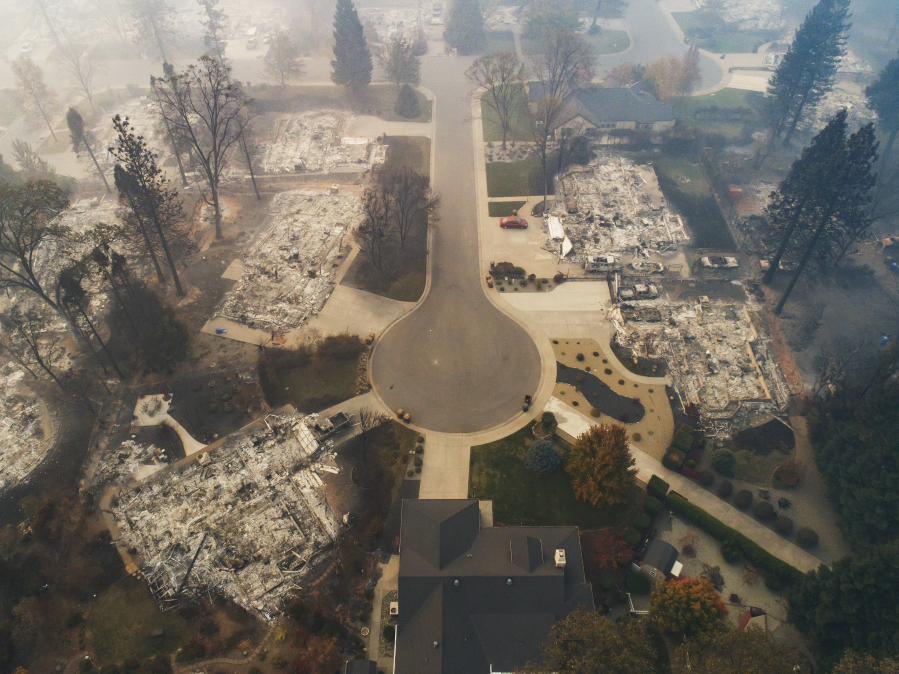One of California’s top elected officials on Monday announced steps to limit how housing and other developments can be built in areas that are at highest risk of wildfire, a move that follows a series of deadly, destructive blazes in recent years, but also comes amid the state’s persistent housing shortage.
At a news conference in San Diego County, state Attorney General Rob Bonta released guidelines for local governments to follow when they are deciding whether to approve subdivisions in the “wildland urban interface” — places where structures and other human development meet undeveloped lands and heighten wildfire risks.
Under Bonta’s guidelines, developers should not be allowed to build on steep slopes in such fire-prone areas, and that they should construct adequate water supplies there, cluster buildings near roads, and be required to use fire-resistant building materials beyond what state building codes require in the riskiest areas.
Made worse by a warming climate that has increased the severity of heat waves and droughts, fires around Lake Tahoe, the Wine Country, Sacramento Valley, Southern California and the Santa Cruz Mountains in the past five years have burned thousands of homes and killed dozens of people.
“This is the new normal,” Bonta said. “When it comes to development we can’t continue business as usual. We must adjust. We must change.”
Monday’s guidelines are voluntary. But not following them carries legal risk.
Bonta’s predecessor, former California Attorney General Xavier Becerra, joined several lawsuits by environmental groups in recent years to block large projects on the grounds that developers and local government officials did not adequately study wildfire risk or take steps to reduce it, as required under the California Environmental Quality Act, a powerful law signed by former Gov. Ronald Reagan in 1970. Bonta continued those lawsuits after he took office last year.
Building industry officials said Monday that the guidelines could be helpful in informing developers and local officials as they design new housing projects.
“We have a housing crisis. We aren’t building enough,” said Dan Dunmoyer, president and CEO of the California Building Industry Association. “So we need to find a way to get to yes. Our goal is to use this guidance to get to yes. Hopefully others won’t use it as a path to keep it at no.”
After some of the most severe fires, particularly the 2018 Camp Fire that killed 85 people and destroyed much of the town of Paradise in Butte County, some state lawmakers have attempted to limit or ban entirely new construction in areas that Cal Fire classifies as “very high wildfire hazard severity zones.”
But most of those measures have been defeated in Sacramento. Last year, Senate Bill 55, by State Sen. Henry Stern, D-Los Angeles, which would have banned development in those areas, failed amid heavy opposition from the building industry.
In 2020, Gov. Gavin Newsom vetoed Senate Bill 182, a measure that would have mandated more evacuation routes, vegetation management and strict building codes for new developments in high-risk fire areas. That bill, by former State Sen. Hannah-Beth Jackson, D-Santa Barbara, passed the Assembly 70-1 and the state Senate 35-2.
In his veto message, Newsom said he supported many of the goals, and that other state agencies were working on them, but that the bill “creates a loophole for regions to not comply with their housing requirements.”
“Wildfire resilience must become a more consistent part of land use and development decisions. However, it must be done while meeting our housing needs,” Newsom wrote.
Environmental groups on Monday cheered Bonta’s actions.
“The solution to California’s housing needs is not to put more people at risk of injury and death from wildfires,” said Peter Broderick, a senior attorney with the Center for Biological Diversity, an environmental group.
Broderick and other environmentalists say they support more housing, particularly in existing urban areas. Building on open range lands and up against forests and fire-prone hillsides increases traffic in rural areas, strains water supplies and heightens wildfire risk, they say.
In January, the center and other environmental groups — joined by Bonta’s office — won a court case to block a proposed luxury development in Lake County on that grounds that developers and county officials did not properly study or offset fire risk, among other issues.
That plan, called Guenoc Valley, proposes to build five resort hotels, a golf course, spas, polo fields and 1,400 luxury homes on 16,000 acres about 15 miles north of Calistoga in southern Lake County.
Similarly, the Sierra Club and other groups won a lawsuit in 2020 to halt construction of a 1,100-home gated community, the Otay Ranch Resort Village, east of Chula Vista in San Diego County, using a similar wildfire safety angle.
Both the Lake County and San Diego County sites had burned in the past 15 years in major wildfires.
“We’re completely in favor of housing where you should build housing,” said Peter Anderson, chairman of the conservation committee of Sierra Club San Diego. “We’re not in favor of building housing that requires long commutes, more greenhouse gases, more traffic and more fire risk.”
Dunmoyer, of the building industry association, noted that the most deaths in any California fire, roughly 3,000, came after the 1906 earthquake in San Francisco. Modern housing is built to strict fire-resistant standards, he said.
“If we are going to not build where the propensity for fire or disaster can occur, we are not going to build in California period,” he said. “Every square inch is prone to earthquake, fire or flood. It comes down to whether we can mitigate for that, and the answer is yes. We think it can be done.”



